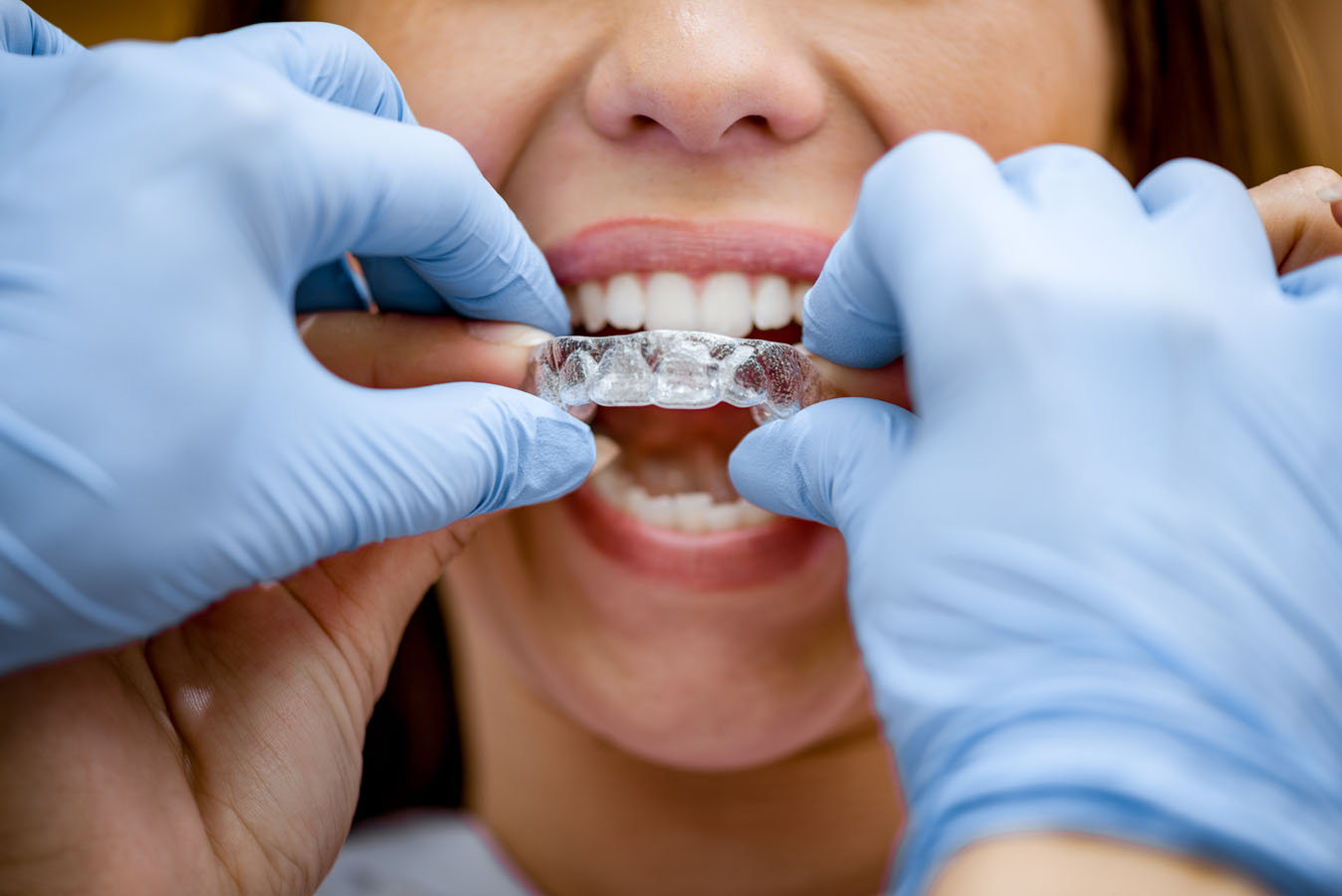Invisalign compared to Braces
Invisalign compared to braces, for many years, metal braces were the only option for those seeking orthodontic treatment to correct crooked or misaligned teeth. However, with the introduction of Invisalign, patients now have a more discreet and comfortable option for straightening their teeth. In this piece, we will compare Invisalign to metal braces and explore the differences between the two treatments.
Invisalign Compared to Braces
The main difference between Invisalign and metal braces is the way they work to straighten teeth. Invisalign is a removable orthodontic appliance, and metal braces are a fixed orthodontic appliance. Metal braces use brackets and wires that are changed over time to shift teeth into the desired position gradually. The metal brackets are glued onto each tooth, and the wire runs between them. The wire is loosely attached to each metal bracket via a small elastic. The wire used is a particular arch shape, which gradually makes the line of teeth, or the arch, conform to that shape. When the teeth are crooked at the start, the wire is more flexible and will not put excessive pressure on any tooth. The early wires tend to be made from nickel titanium. Later, the wires are larger, more rigid, and tend to be stainless steel.
In contrast, Invisalign uses a series of custom-made, clear, removable aligners for each patient to gradually shift teeth into the desired position. Invisalign digitally moves the teeth and prints a model of that position. An aligner is then constructed on that model. The teeth are then moved a little more, another aligner is built, and so on, until a sequence of aligners exists with the teeth finishing in the optimal spot.
The most significant difference between the two treatment types is the required effort. Once you have good oral hygiene- which is challenging with a tonne of metal in your mouth- metal braces continue to work away of their own accord. Invisalign, in contrast, requires more care. It is nothing too extensive but does require a bit of discipline.
Meta braces are certainly not pretty, but they are very socially acceptable in modern society. It certainly also takes a while for the soft tissues of the mouth to get used to the rough nature of the metal braces appliance. Invisalign is undoubtedly much, much, much more aesthetic and is mainly invisible from any distance. Invisalign is also very smooth and non-irritant to the mouth’s soft tissues. Crucially, Invisalign can be removed to clean your teeth. That is an advantage for most people, if not all. It’s primarily an advantage for those who struggle with their oral hygiene or have dental disease in the past.
Some mouths are high maintenance! Equally, medical histories may cause people to have teeth that may need to be minded more. Removability is not an advantage with woolly-headed teenagers who may remove them and not put them back in or, worse, lose them. Also, if oral hygiene is bad, you are probably not suitable for orthodontics.
Comparing Invisalign with Metal Braces
Invisalign vs. Braces Cost:
Regarding cost, metal braces are typically less expensive than Invisalign. The average cost of metal braces can range from €1500 to €3800, while the average cost of Invisalign can range from €2100 to €4600. However, the cost of each treatment will depend on the severity of the orthodontic issue and the length of the treatment plan.
Below are the list of our orthodontic treatment costs to give you an idea
| Treatment | Price |
|---|---|
| Orthodontic Consultation | FREE |
| Removable Retainer | €120 |
| Fixed Retainer | €250 |
| Quick Straight Teeth - 1 Arch | €2200 |
| Quick Straight Teeth - Both Arches | €3000 |
| Invisalign - Express - 1 arch | €2400 |
| Invisalign - Express- Both arches | €2800 |
| Invisalign - Lite - 1 arch | €2995 |
| Invisalign - Lite - Both arches | €3900 |
| Invisalign – Moderate – Single arch | €3500 |
| Invisalign – Moderate – Both arches | €4300 |
| Invisalign - Comprehensive | €4800 |
| Whitening After Invisalign | FREE |
| Fixed Metal Braces - 1 arch | €2500 |
| Fixed Metal Braces - Both arches | €4200 |
| Ceramic Fixed Braces - 1 Arch | €2800 |
| Ceramic Fixed Braces - Both arches | €4400 |
Braces vs. Invisalign for Overbite:
Both metal braces and Invisalign can effectively treat overbite, which occurs when the upper front teeth extend too far over the lower front teeth. However, metal braces may be more effective for severe overbite cases, as they provide more control over the movement of the teeth. Braces have been shown to have better root control over the teeth- that is, they are better at putting the roots of the teeth in the correct place. This marriage of the root position of the front teeth and the angle the top and bottom front teeth make to each other is important to the after-treatment stability of deep bite cases. Invisalign can be very effective for mild to moderate overbite cases, as the aligners can gradually shift the teeth into the desired position. In essence, Invisalign and aligners are generally better at pushing in back-teeth than pulling them up. To correct a deep bite, it is usually desirable to get the molar teeth to grow down a little from the upper and up a little from the lower, thereby increasing the height at the back and reducing the vertical overlap at the front. Braces are slightly better at those molar movements. The opposite is true of open bites where, indeed, Invisalign may have the advantage as it is better at pushing or intruding the molar teeth, decreasing the height at the back to allow the teeth to overlap better at the front.
Is Invisalign as Good as Braces?
Invisalign and metal braces are both effective orthodontic treatment options for straightening teeth. Invisalign offers several benefits over metal braces, including greater comfort, fewer hygiene problems, and a more discreet appearance. However, metal braces may be more effective for more severe orthodontic issues and are typically less expensive than Invisalign. Previously, metal braces had an advantage in the quality of outcome from an orthodontic point of view. Studies have shown that traditional braces may be better at controlling where the roots of the teeth go. Even though it is widely studied, there is still no black-and-white answer as to which system works best, and a lot of studies are based on case studies. That is where an individual practitioner or a group of dentists will comment on the cases they have treated. These studies can have a lot of bias as it is human nature to make yourself appear in the best light. However, with advances in materials and other technological features, that gap has now largely closed. Invisalign can now place the roots of the teeth much more accurately than it could previously, and there is generally no difference in the standards in a well-planned and suitable case.
Ultimately, the decision between Invisalign and metal braces will depend on various factors, including the individual’s orthodontic needs, preferences, and budget for treatment. It’s essential to consult with a dental professional to determine which treatment option is best suited for your individual needs and dental goals.
In conclusion, both Invisalign and metal braces are effective at moving teeth. Some cases will still suit either modality better or vice versa. It is now mainly possible to get a perfect result with either appliance for most situations, however. The secret to all orthodontics is planning. Planning involves accurate record-taking in the first place to plan the case at hand correctly. This starts with what the patient is hoping for first and foremost, and that’s the destination. The appliance is the journey. A free consultation at Cork City Dentist makes the decision a bit easier. This will involve a discussion about what you would like to get out of your orthodontic treatment and then the best route to get there. This will include an analysis of your ability to get on with whichever treatment option.






